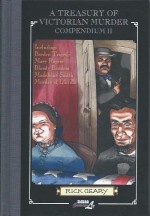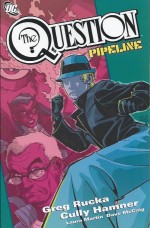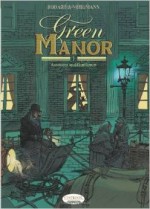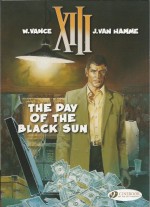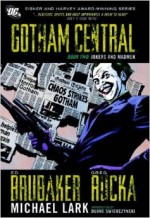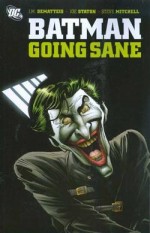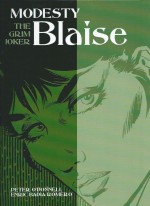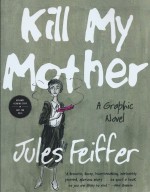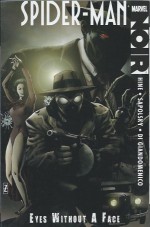
By David Hine & Carmine Di Giandomenico, with June Chung (Marvel)
ISBN: 978-0-7851-4450-2
When fictional heroes and villains become really popular – to the point where fans celebrate their births and deaths and dress up like them at the slightest opportunity or provocation – eventually a tendency develops to explore other potential character facets that the regular, cash-cow continuity might normally prohibit.
DC invented a whole company sub-strand of “Imaginary Stories†and Marvel asked “What If…?â€, sharing glimpses of alternate realities. Even television series got into the act with shows like Star Trek, Roswell and Stargate SG-1 offering coolly jarring, different takes on their established stars and scenarios.
The nasty little gem of alternate continuity on view today stems from Marvel’s intriguing experiment of 2009 wherein many of their biggest stars were reconfigured and set back in time: populating a universe drenched in the tone, lore and ephemera of pulp fiction and Film Noir. This iconic 1930s milieu was a grim and grimy land where shiny gleaming super-powered heroes were replaced by stark, paranoid, deeply flawed and self-serving individuals just trying to get by as best they could…
Spider-Man Noir: Eyes Without a Face is a sequel to an initial “origin†yarn and benefits from not having to explain or differentiate the so-similar seeming stars from the bastions of the regular continuity.
It ran as a 4-issue miniseries from February to May 2010, offering a glimpse into a moody world with no heroes, only varying shades of villainy. Nevertheless it still provides a satisfying slice of suspenseful entertainment for Fights ‘n’ Tights fans in search of something genuinely edgier than their regular fare. After all, the big draw for the jaded is that these folks might actually die and stay that way…
What You Need to Know: living in Depression-era New York City, the nephew of liberal activists Ben and May Parker was bitten by a strange tropical spider, developing rather strange attributes. The hot-headed radical used those newfound abilities and the files of reporter/extortionist Ben Urich to bring down the corrupt Mayor and his audacious criminal partner Norman Osborn AKA The Goblin.
Sadly the clearing-out of the town’s most powerful individuals only allowed a whole new echelon of murderous scum to come to the fore.
Now a junior photojournalist for the crusading Daily Bugle, Peter Parker moonlights as the trench-coated, wall crawling mystery man dubbed the Spider-Man, striving to keep the streets clean and give the little guys a break in an uncaring world of callous giants…
It all begins ‘Around Midnight’ in September 1933. The Spider-Man has prowled the dark streets for eight months but despite his best efforts crime is still rampant. Local Bureau of Investigation Chief Agent Jean De Wolfe is running out of informants as new underworld supremo Crime Master exerts growing control over the mobs, aided by his taciturn enforcer “The Sandmanâ€.
When the Arachnid Avenger discovers a theatre full of slaughtered crooks he heads straight for his paramour and occasional ally Felicia Hardy, hopeful that she’s overheard something at her Black Cat Nightclub – a speakeasy regarded as neutral territory by crooks and cops alike.
She is less than forthcoming… at least with information…
Heading home to the Bowery Welfare Center in the grey morning light, Peter meets old friend and fellow agitator Robbie Robertson. The hothead is sounding off about new President Franklin Roosevelt and questioning how his proposed New Deal reforms will affect the situation of black people in America…
The brilliant and passionate young man works for the city’s segregated newspaper The Negro World and knows how things really work. Furthermore, Robbie shares with his old marching comrade suspicions that the government have something covert going on with prominent biologist Dr. Otto Octavius on Ellis Island. Being “a colouredâ€, Robbie has been refused an interview. Perhaps Peter could use his Bugle credentials to facilitate the matter?
Three days later the journalists are being greeted – albeit with exceeding different degrees of warmth – by the researcher’s assistant Curtis Connors before being ushered into a lab where wheelchair-bound and severely handicapped Octavius is finishing up appallingly sadistic experiments on a number of primates…
As they return to Manhattan, Robertson declares that something even worse is going on and resolves to go back for a look without the scientist’s Aryan-seeming minders tagging along. He doesn’t share his suspicions that the doctor’s passion for mind-control surgeries might be connected to a rash of disappearances of black citizens from Harlem…
‘Night Music’ follows escalating gang conflict as Crime Master tightens his stranglehold on the mobs and the Spider-Man spectacularly raids Harlem nightspot Seventh Heaven to discover what manager Fat Larry claims is just a faked-up dungeon room for clients with “exotic tastesâ€. It smells like the real thing to Peter…
Later, as Parker gloats over his first scoop for the Bugle, Robbie’s dad comes knocking. His proud, brilliant, too-inquisitive boy has gone missing…
Introducing his prospective daughter-in-law Gloria, the elder Robertson explains Robbie had been looking into reports of missing blacks and a possible white supremacy movement in New York. He was especially concerned about inroads into the government and possible links to Nazi Germany…
Having been roundly abused by the police when they tried to report him missing, the desperate family have come to Peter hoping he might have an idea.
He has only one and immediately rushes out to a nightclub in Harlem.
Elsewhere in town Octavius’ supplier of raw material and suitable test subjects is being carpeted by his clandestine backer Josef Ansell. Crime Master has no interest in the theories of the American Nazi party but revels in the power of his new position. He is not happy to hear his boss screaming over his performance and failure to deal with the Spider-Man.
Later, in the devil’s doctor’s fortress of obscene science, Octavius and Josef debate theories of racial purity and controlling the sub-human races through the creepily dispassionate butcher’s radical new surgical discovery. Today we call it lobotomising…
Berlin favours simply eradicating the lower orders but Octavius is convinced his scheme is better. Surely it’s more economically sensible to simply remove the capacity for rebellion and employ the sub-humans as tractable, ever-obedient slaves?
Considering the argument won he turns his attention back to Robbie, trussed up but awake on an operating table…
The Spider-Man, meanwhile, has reached Seventh Heaven to check out that dungeon again only to walk into a trap. Leading the overconfident army of thugs are Crime Master and his hulking Sandman, a brute seemingly oblivious to pain or injury…
Acting on a tip, De Wolfe and his team break in just in time to save the ambushed arachnoid from being beaten to death. As ‘Blues in the Night’ further unfolds, the battered vigilante shares his knowledge of the Negro disappearances and profound belief that Otto Octavius is behind them.
Still reeling, Peter then goes to Felicia for comfort and medical assistance but she can’t minister to him for long. She has a very important client coming who doesn’t like to share. However when she inadvertently questions her mystery high-roller about the Harlem abductions she tips her hand and the Crime Master sadistically makes her regret nosing into his business…
With his shielding veils of respectability and political secrecy tearing all around him, Josef frantically prepares to up stakes and relocate to somewhere more isolated and less troublesome like Tuskegee, Alabama, but the vengeful Arachnid is already deep within the Ellis Island facility and has seen what’s been done to Robbie…
The horrific pot of bubbling hatreds boil over in ‘Endless Night’ as obsessed Octavius rails against his backers whilst Crime Master and his goons ignore his protestations and get rid of the “livestock†and evidence of the doctor’s “scientific breakthroughsâ€.
By the time the Spider-Man joins the fight the supremacist thug and theoretician have almost killed each other but that doesn’t prevent the outraged avenger exacting his own measure of vengeance…
If he had known what Crime Master had left of Felicia, The Spider-Man might not have gone so easy on the monsters…
Bleak, gutsy, galvanising and trenchantly effective, this excellent period thriller by scripter David Hine & illustrator Carmine Di Giandomenico offers a stunningly suspenseful serving of dark drama and gripping action which would work equally well even if you had never heard of Marvel’s wondrous wallcrawler.
This pocketbook sized collection also includes a covers gallery by Di Giandomenico with variants by Dennis Calero as well as original art pages of variant options, inked art shot prior to the digital colouring stage and an extended script excerpt by Hine & Fabrice Sapolsky from issue #1, illustrated with character design sketches by Di Giandomenico.
© 2010 Marvel Characters, Inc. All rights reserved.

